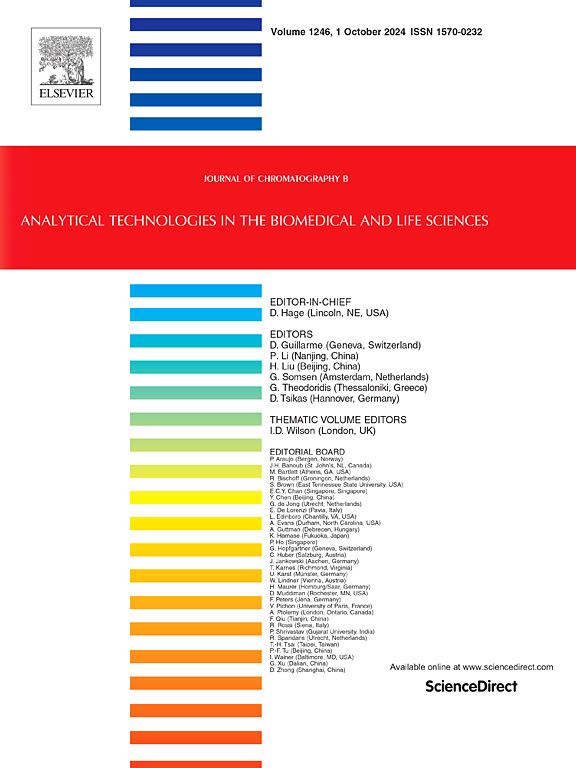Development and validation of a LC–MS/MS method for the detection of 38 benzodiazepines and 2 Z-drugs in blood
IF 2.8
3区 医学
Q2 BIOCHEMICAL RESEARCH METHODS
引用次数: 0
Abstract
Benzodiazepines and Z-drugs are commonly used as prescription medications to treat anxiety, epilepsy, insomnia, and alcohol withdrawal syndrome, but their use can lead to tolerance, dependence, and withdrawal reactions if taken against official guidelines. Furthermore, designer benzodiazepines, most of which lack clinical and toxicological data, have entered the illicit drug market as new psychoactive substances and are used for recreational purposes. Their abuse can cause confusion, memory loss, respiratory depression, and even death, especially when combined with other sedative-hypnotics or alcohol. Therefore, new qualitative and quantitative methods for benzodiazepines and Z-drugs are needed for use in forensic and clinical toxicology. This study explored the sample preparation and liquid-liquid extraction using 0.5 mL blood samples and 2 mL of extraction solvent for analysis of these drugs by liquid chromatography-tandem mass spectrometry and multiple reaction monitoring. The benzodiazepines were separated on a pentafluorophenylpropyl (PFPP) column using a mobile phase gradient consisting of A (water, 0.1 % formic acid, 5 % acetonitrile, and 20 mmol/L ammonium acetate) and B (acetonitrile) for 9 min. Validation steps confirmed that the method demonstrated good selectivity, sensitivity (limit of detection: 0.2 ng/mL, lower limit of quantification: 0.5 ng/mL), linearity (R2 ≥ 0.99), accuracy, and precision (<20 %). Matrix effects ranged from 35 to 126 %, and recoveries ranged from 17 to 99 %, with 35 compounds having recoveries of more than 50 %. The method was successfully applied for the identification and quantification of benzodiazepines and nonbenzodiazepines in blood samples from 15 authentic poisoning cases. Ten analytes were detected: alprazolam (130.2–575.3 ng/mL), hydroxyalprazolam (2.3–37.3 ng/mL), clonazepam (11.7–773.2 ng/mL), lorazepam (63.4–166.9 ng/mL), 7-aminoclonazepam (17.4–385.3 ng/mL), oxazepam (2.6–964.1 ng/mL), diazepam (227.2 ng/mL), nordazepam(22.4 ng/mL), zolpidem (11.8–64.0 ng/mL), midazolam (70.2 ng/mL), and hydroxymidazolam (162.8 ng/mL).
hplc - MS/MS检测血液中38种苯二氮卓类药物和2种z类药物的方法建立与验证
苯二氮卓类药物和z类药物通常被用作治疗焦虑、癫痫、失眠和酒精戒断综合征的处方药,但如果违反官方指南,它们的使用可能导致耐受性、依赖性和戒断反应。此外,设计苯二氮卓类药物大多数缺乏临床和毒理学数据,已作为新的精神活性物质进入非法药物市场,并被用于娱乐目的。滥用这些药物会导致精神错乱、记忆力减退、呼吸抑制,甚至死亡,尤其是与其他镇静催眠药或酒精结合使用时。因此,苯二氮卓类药物和z类药物需要新的定性和定量方法用于法医和临床毒理学。本研究采用0.5 mL血液样品和2 mL萃取溶剂制备样品和液液萃取,采用液相色谱-串联质谱法和多重反应监测对上述药物进行分析。采用流动相梯度a(水、0.1%甲酸、5%乙腈、20 mmol/L乙酸铵)和B(乙腈),在五氟苯丙基(PFPP)柱上分离苯二氮卓类药物,分离时间为9 min。验证步骤证实该方法具有良好的选择性、灵敏度(检测限:0.2 ng/mL,定量下限:0.5 ng/mL)、线性度(R2≥0.99)、准确度和精密度(< 20%)。基质效应范围为35% ~ 126%,加样回收率为17% ~ 99%,其中35个化合物加样回收率大于50%。该方法成功地应用于15例真实中毒病例血液样本中苯二氮卓类和非苯二氮卓类药物的鉴定和定量。共检测10种分析物:阿普唑仑(130.2 ~ 575.3 ng/mL)、羟阿普唑仑(2.3 ~ 37.3 ng/mL)、氯硝西泮(11.7 ~ 773.2 ng/mL)、劳拉西泮(63.4 ~ 166.9 ng/mL)、7-氨基氯硝西泮(17.4 ~ 385.3 ng/mL)、奥西泮(2.6 ~ 964.1 ng/mL)、地西泮(227.2 ng/mL)、去甲达西泮(22.4 ng/mL)、唑吡坦(11.8 ~ 64.0 ng/mL)、咪达唑仑(70.2 ng/mL)、羟咪达唑仑(162.8 ng/mL)。
本文章由计算机程序翻译,如有差异,请以英文原文为准。
求助全文
约1分钟内获得全文
求助全文
来源期刊

Journal of Chromatography B
医学-分析化学
CiteScore
5.60
自引率
3.30%
发文量
306
审稿时长
44 days
期刊介绍:
The Journal of Chromatography B publishes papers on developments in separation science relevant to biology and biomedical research including both fundamental advances and applications. Analytical techniques which may be considered include the various facets of chromatography, electrophoresis and related methods, affinity and immunoaffinity-based methodologies, hyphenated and other multi-dimensional techniques, and microanalytical approaches. The journal also considers articles reporting developments in sample preparation, detection techniques including mass spectrometry, and data handling and analysis.
Developments related to preparative separations for the isolation and purification of components of biological systems may be published, including chromatographic and electrophoretic methods, affinity separations, field flow fractionation and other preparative approaches.
Applications to the analysis of biological systems and samples will be considered when the analytical science contains a significant element of novelty, e.g. a new approach to the separation of a compound, novel combination of analytical techniques, or significantly improved analytical performance.
 求助内容:
求助内容: 应助结果提醒方式:
应助结果提醒方式:


